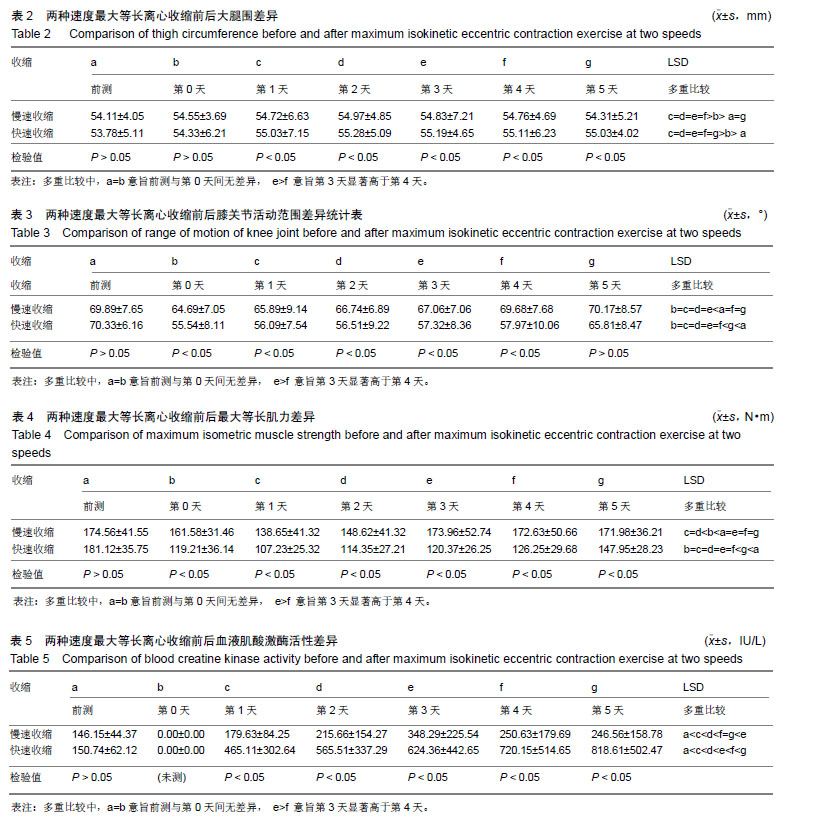中国组织工程研究 ›› 2019, Vol. 23 ›› Issue (31): 4962-4968.doi: 10.3969/j.issn.2095-4344.1454
• 肌肉肌腱韧带组织构建 tissue construction of the muscle, tendon and ligament • 上一篇 下一篇
快、慢两种速度下最大等速离心运动训练对伸膝肌群的影响
刘 贇
- (重庆应用技术职业学院,重庆市 401520)
Effect of maximum isokinetic centrifugal exercise training at fast and slow speeds on knee extensors
Liu Yun
- (Chongqing Vocational College of Applied Technology, Chongqing 401520, China)
摘要:
文章快速阅读:
.jpg)
文题释义:
离心收缩:是指肌肉在外力作用而伸展的情况下产生张力,即肌肉在被迫伸展时产生收缩,此种收缩形式与向心收缩相反,其所产生的张力,在各种肌肉收缩型式中为最大。离心运动所征募的肌纤维数目较少,但产生的力量却较大,故每一条肌纤维的负荷相对提高,所以在反复高张力下的离心收缩,往往会导致肌纤维及肌肉功能受到损伤,则高张力、低神经激活是离心收缩的最大特性。
延迟性肌肉酸痛(delayed onset muscle soreness,DOMS):常发生于不熟悉的运动形态,如下坡跑步或运动强度超出平时的训练,特别是肌肉在从事反复离心收缩的运动过程中,会促使骨骼肌引起很明显的伤害。一般肌肉损伤症状有肌肉酸痛加剧、关节活动范围变窄、最大自主等长肌力下降等现象;其中肌肉酸痛程度通常在运动后的1-3 d最为明显,在4-6 d达到峰值,在5-7 d后才能逐渐缓解并恢复。
.jpg)
文题释义:
离心收缩:是指肌肉在外力作用而伸展的情况下产生张力,即肌肉在被迫伸展时产生收缩,此种收缩形式与向心收缩相反,其所产生的张力,在各种肌肉收缩型式中为最大。离心运动所征募的肌纤维数目较少,但产生的力量却较大,故每一条肌纤维的负荷相对提高,所以在反复高张力下的离心收缩,往往会导致肌纤维及肌肉功能受到损伤,则高张力、低神经激活是离心收缩的最大特性。
延迟性肌肉酸痛(delayed onset muscle soreness,DOMS):常发生于不熟悉的运动形态,如下坡跑步或运动强度超出平时的训练,特别是肌肉在从事反复离心收缩的运动过程中,会促使骨骼肌引起很明显的伤害。一般肌肉损伤症状有肌肉酸痛加剧、关节活动范围变窄、最大自主等长肌力下降等现象;其中肌肉酸痛程度通常在运动后的1-3 d最为明显,在4-6 d达到峰值,在5-7 d后才能逐渐缓解并恢复。
摘要
背景:日常生活中的下阶梯、下坡跑、深蹲训练等,此时人体下肢肌群处于离心收缩很容易引发伸膝肌群酸痛及造成肌肉细微损伤现象,但目前缺少以相同等速离心速度的屈肘肌方案应用于伸膝肌的所引发损伤报道。
目的:对膝伸肌群分别采用快、慢2种速度进行一回合最大等速离心收缩运动,据此揭示该训练模式可能引发的肌肉损伤规律。
方法:该研究方案经重庆应用技术职业学院的医学伦理委员会审核通过。以16名未接受过训练的健康大学男性为受试对象,所有受试者均在充分了解试验方案的前提下签署了“知情同意书”。在为期2周内,运用平衡次序法让每一位受试者的左、右腿分别使用快、慢2种速度,进行一回合120 s最大等速离心收缩运动。慢速度为30 (°)/s的角速度下进行6组×5次;快速度为210 (°)/s的角速度下进行次6组×35次。并于运动前、后分别测试肌肉酸痛程度、大腿围、膝关节活动范围、最大自主等长肌力、血液肌酸激酶活性等指标。
结果与结论:①不同速度进行最大等速离心收缩训练,皆在结束后两三天肌肉酸痛达到峰值,表现为快速下诱发的肌肉酸痛程度比慢速更严重,但两者皆可在运动结束后第5天恢复到训练前水平;②不同速度进行最大等速离心收缩训练皆能引发大腿围增加,但快速下大腿围增幅显著高于慢速且恢复速度更慢;③快速下进行最大等速离心收缩训练后膝关节活动范围、最大等长肌力皆显著小于慢速训练,且两者恢复速度也差异明显,表现为慢速训练结束后膝关节活动范围及最大等长肌力下降值较低,约在结束后第3天就基本恢复到训练后水平;而快速情况下,膝关节活动范围及最大等长肌力下降程度大,峰值出现更晚,恢复时间更长,在训练结束第5天依旧未能完全恢复;④快速训练诱发血液肌酸激酶的活性显著高于慢速,且慢速训练很快能获得恢复,但快速组在训练结束第5天血液肌酸激酶酶活性还在增加,这足见快速引发肌肉损伤比慢速要大得多;⑤结果说明,离心收缩所引发的肌肉酸痛程度、大腿围、膝关节活动范围、最大等长肌力、血液肌酸激酶、肌力峰值等值及恢复时间差异可能与离心“训练总量”有关;在控制快、慢2种速度肌肉激活时间前提下,快速下的最大等速离心训练所引起肌肉损伤程度显著高于慢速度,从而支持离心收缩速度与肌肉损伤有关的论断,亦证实了快速离心运动较容易引起肌肉损伤的观点。
背景:日常生活中的下阶梯、下坡跑、深蹲训练等,此时人体下肢肌群处于离心收缩很容易引发伸膝肌群酸痛及造成肌肉细微损伤现象,但目前缺少以相同等速离心速度的屈肘肌方案应用于伸膝肌的所引发损伤报道。
目的:对膝伸肌群分别采用快、慢2种速度进行一回合最大等速离心收缩运动,据此揭示该训练模式可能引发的肌肉损伤规律。
方法:该研究方案经重庆应用技术职业学院的医学伦理委员会审核通过。以16名未接受过训练的健康大学男性为受试对象,所有受试者均在充分了解试验方案的前提下签署了“知情同意书”。在为期2周内,运用平衡次序法让每一位受试者的左、右腿分别使用快、慢2种速度,进行一回合120 s最大等速离心收缩运动。慢速度为30 (°)/s的角速度下进行6组×5次;快速度为210 (°)/s的角速度下进行次6组×35次。并于运动前、后分别测试肌肉酸痛程度、大腿围、膝关节活动范围、最大自主等长肌力、血液肌酸激酶活性等指标。
结果与结论:①不同速度进行最大等速离心收缩训练,皆在结束后两三天肌肉酸痛达到峰值,表现为快速下诱发的肌肉酸痛程度比慢速更严重,但两者皆可在运动结束后第5天恢复到训练前水平;②不同速度进行最大等速离心收缩训练皆能引发大腿围增加,但快速下大腿围增幅显著高于慢速且恢复速度更慢;③快速下进行最大等速离心收缩训练后膝关节活动范围、最大等长肌力皆显著小于慢速训练,且两者恢复速度也差异明显,表现为慢速训练结束后膝关节活动范围及最大等长肌力下降值较低,约在结束后第3天就基本恢复到训练后水平;而快速情况下,膝关节活动范围及最大等长肌力下降程度大,峰值出现更晚,恢复时间更长,在训练结束第5天依旧未能完全恢复;④快速训练诱发血液肌酸激酶的活性显著高于慢速,且慢速训练很快能获得恢复,但快速组在训练结束第5天血液肌酸激酶酶活性还在增加,这足见快速引发肌肉损伤比慢速要大得多;⑤结果说明,离心收缩所引发的肌肉酸痛程度、大腿围、膝关节活动范围、最大等长肌力、血液肌酸激酶、肌力峰值等值及恢复时间差异可能与离心“训练总量”有关;在控制快、慢2种速度肌肉激活时间前提下,快速下的最大等速离心训练所引起肌肉损伤程度显著高于慢速度,从而支持离心收缩速度与肌肉损伤有关的论断,亦证实了快速离心运动较容易引起肌肉损伤的观点。
中图分类号:



.jpg)
.jpg) #br#
文题释义:#br#
离心收缩:是指肌肉在外力作用而伸展的情况下产生张力,即肌肉在被迫伸展时产生收缩,此种收缩形式与向心收缩相反,其所产生的张力,在各种肌肉收缩型式中为最大。离心运动所征募的肌纤维数目较少,但产生的力量却较大,故每一条肌纤维的负荷相对提高,所以在反复高张力下的离心收缩,往往会导致肌纤维及肌肉功能受到损伤,则高张力、低神经激活是离心收缩的最大特性。#br#
延迟性肌肉酸痛(delayed onset muscle soreness,DOMS):常发生于不熟悉的运动形态,如下坡跑步或运动强度超出平时的训练,特别是肌肉在从事反复离心收缩的运动过程中,会促使骨骼肌引起很明显的伤害。一般肌肉损伤症状有肌肉酸痛加剧、关节活动范围变窄、最大自主等长肌力下降等现象;其中肌肉酸痛程度通常在运动后的1-3 d最为明显,在4-6 d达到峰值,在5-7 d后才能逐渐缓解并恢复。
#br#
文题释义:#br#
离心收缩:是指肌肉在外力作用而伸展的情况下产生张力,即肌肉在被迫伸展时产生收缩,此种收缩形式与向心收缩相反,其所产生的张力,在各种肌肉收缩型式中为最大。离心运动所征募的肌纤维数目较少,但产生的力量却较大,故每一条肌纤维的负荷相对提高,所以在反复高张力下的离心收缩,往往会导致肌纤维及肌肉功能受到损伤,则高张力、低神经激活是离心收缩的最大特性。#br#
延迟性肌肉酸痛(delayed onset muscle soreness,DOMS):常发生于不熟悉的运动形态,如下坡跑步或运动强度超出平时的训练,特别是肌肉在从事反复离心收缩的运动过程中,会促使骨骼肌引起很明显的伤害。一般肌肉损伤症状有肌肉酸痛加剧、关节活动范围变窄、最大自主等长肌力下降等现象;其中肌肉酸痛程度通常在运动后的1-3 d最为明显,在4-6 d达到峰值,在5-7 d后才能逐渐缓解并恢复。